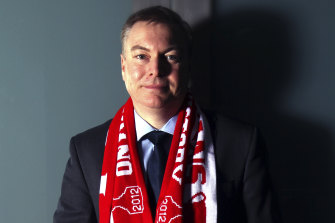
Pridham said the financial projections made ahead of Gold Coast and the Giants’ entry into the competition led to clubs backing their entry, but with the benefit of hindsight it “was fair to say [those projections] probably missed by a fair bit”. The two teams received combined AFL funding of $49 million in 2021.
The Age revealed this year that those expansion clubs who play in non-traditional football states received $352 million funding from the AFL between 2012-2020.
The Tasmanian AFL Licence Taskforce presented their business case to the league at the start of 2020. Former Geelong president and AFL Commissioner Colin Carter then reviewed it last year and found the case was economically viable. He left the door open for relocation or a hybrid model but said a standalone team could work on the financial modelling done by the bid team.
The Tasmanian Government pays for Hawthorn and the Kangaroos to play home games in Launceston and Hobart.

Andrew Pridham.Credit:Peter Braig
The AFL committed to a vote from presidents in August, however, the retirement of Tasmanian premier Peter Gutwein, uncertainty about the real cost of a new stadium in Hobart and the AFL’s unwillingness to guarantee more than $8 million per year in funding, as the Tasmanian Government offered to commit $150 million to the team over 10 years, has stifled the bid’s momentum.
The bid team have said the financial projections weren’t dependent on a new stadium being built, but some clubs see that development as critical to a standalone team.
“If there is no stadium I don’t think there is a Tasmanian standalone team,” Pridham said.
“I have an open mind. I am emotionally very willing to see Tasmania get a great AFL experience.”
Geelong have thrown their support publicly behind Tasmania’s bid for a standalone team while Essendon president Paul Brasher is keeping an open mind.









 Add Category
Add Category